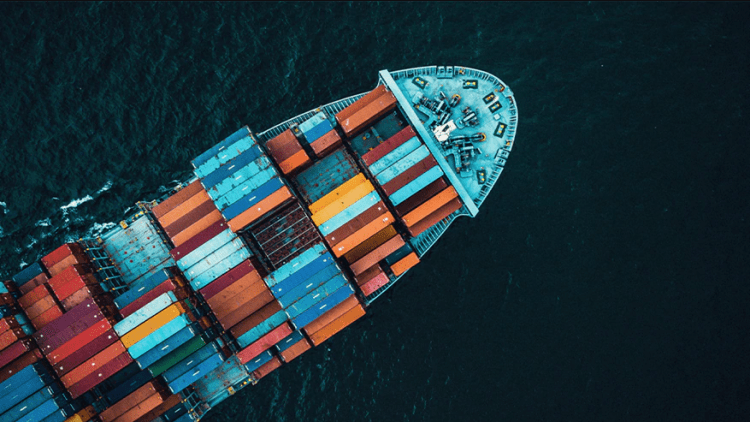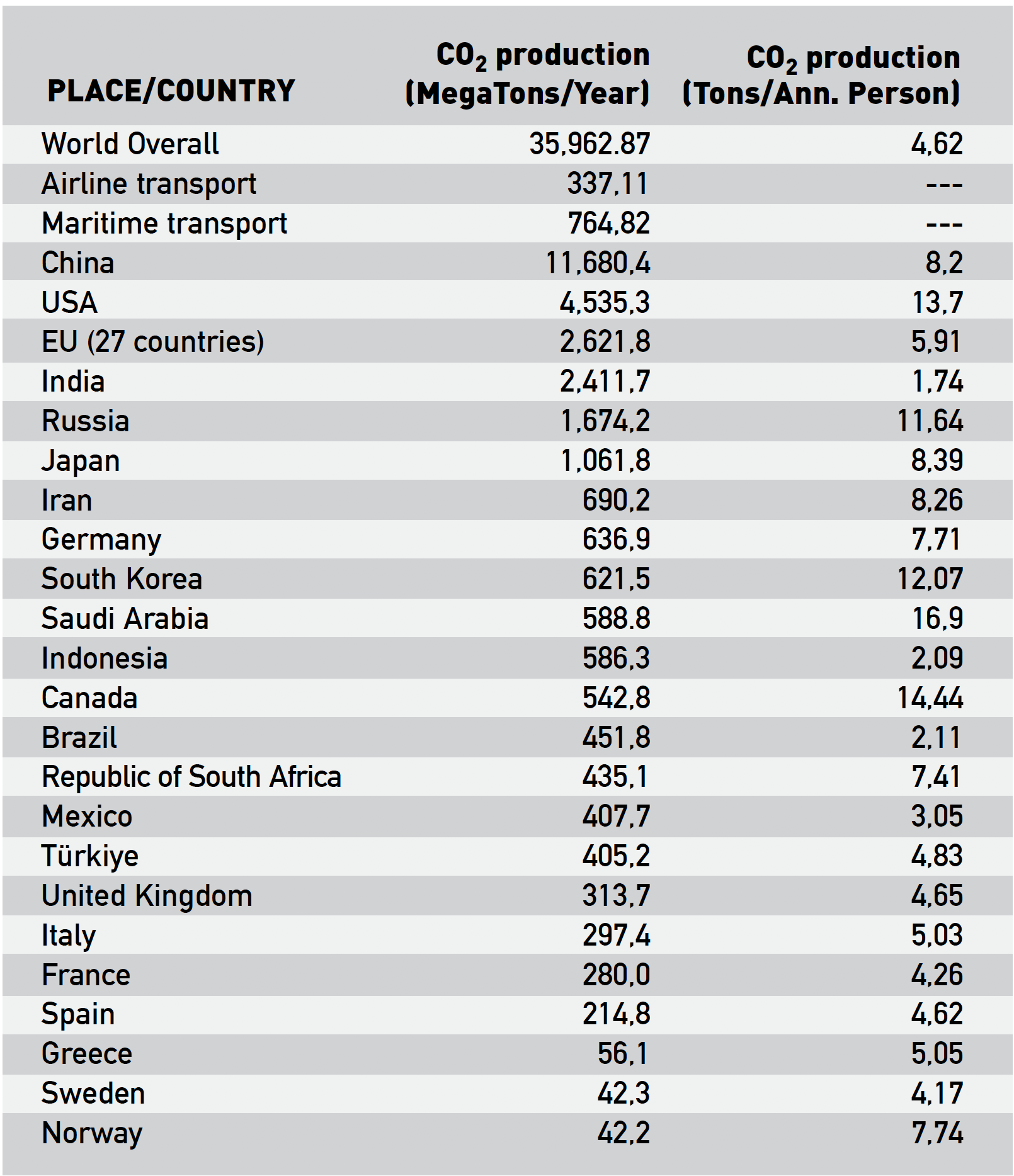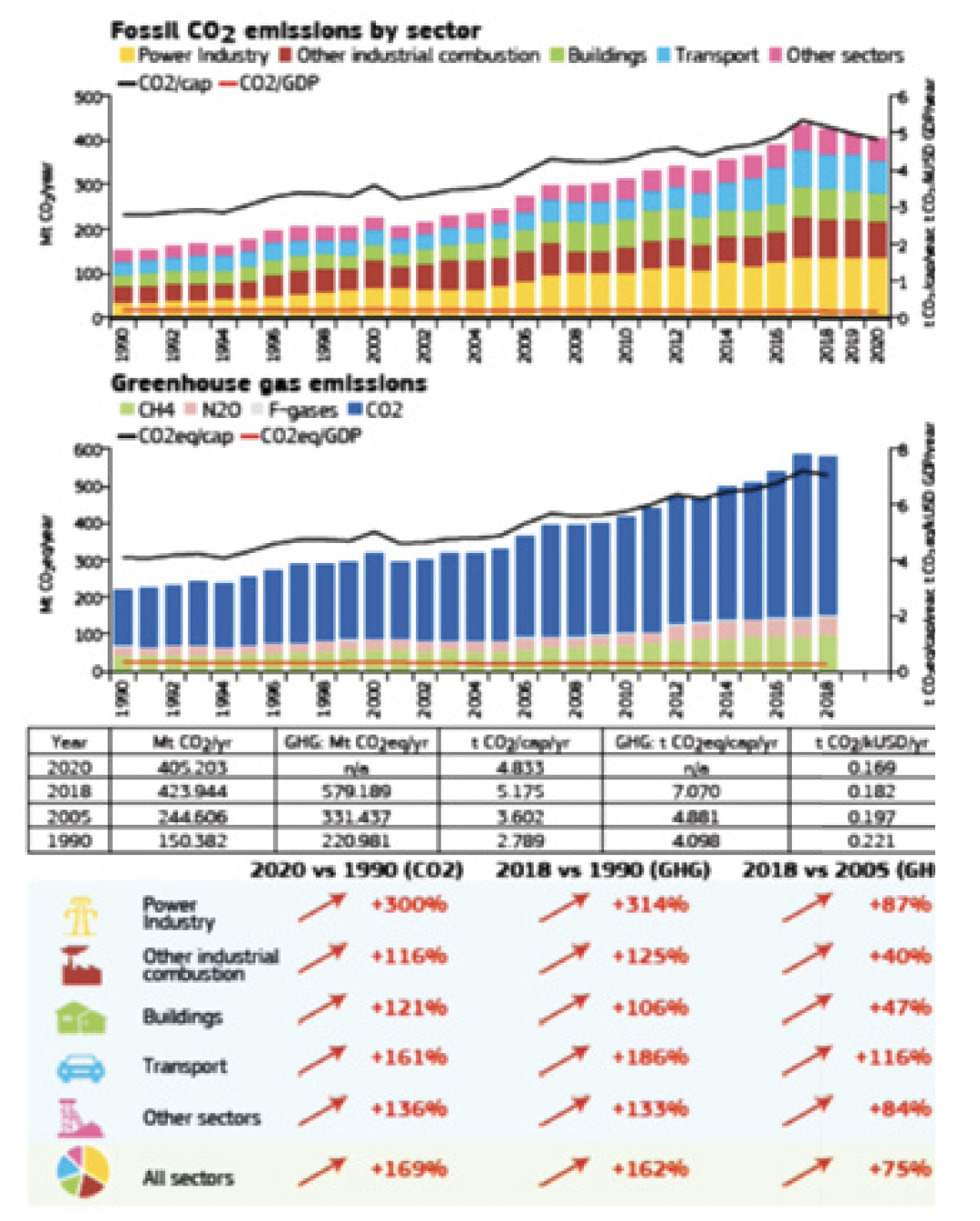 Istanbul Technical University (ITU) Shipbuilding and Marine Sciences, Naval Architecture and Ocean Engineering Faculty Member Prof. Dr. Osman Azmi Özsoysal viewed the new ship trends as well as green fuels which have become prominent in research conducted to limit carbon emission in the struggle against climate change for MarineDeal News readers in an educational and technical style Scientific research in global warming lists disaster scenarios
Istanbul Technical University (ITU) Shipbuilding and Marine Sciences, Naval Architecture and Ocean Engineering Faculty Member Prof. Dr. Osman Azmi Özsoysal viewed the new ship trends as well as green fuels which have become prominent in research conducted to limit carbon emission in the struggle against climate change for MarineDeal News readers in an educational and technical style Scientific research in global warming lists disaster scenarios
First, we cut off trees for warmth and shelter, destroyed forests; then we cut down trees again to make wood charcoal as we realized the high level of energy it produces, and destroyed greenery. Later on, we cut down trees again to provide for our increasing population and created farming lands. Much later, we destroyed forests for our growing cities and roads. We burned the mined coal for energy and released carbon to nature. That wasn’t enough, we continued releasing carbon by using fossil fuels. The massive energy needed for transportation and industrial areas resulted in the release of great amounts of carbon into nature. Scientists have been warning for years, we said they talk too much, that they should keep it to themselves; we disregarded them for the sake of our greed for income. Today, we are approaching the end of the road and we are at the last stop. What percentage of people truly realize that we are at the last stop and are concerned about it? This is the most important question that has to be answered. If everybody does not show interest in reducing carbon emission all together, it will be too late for all of us. The issue is not knocking on our door, it is pounding and is almost about to break the door… Scientific research lists global disaster scenarios one after the other. We don’t have much choice. All national and local administrations will either fully participate in this struggle together with their own people or we and the generation right after us will witness famine, drought, migration and global wars along with global warming. We are desperately in need of not only trees but even the greenery, the grass as a precaution. If we continue to behave like mischievous and disobedient children, then nature will protect itself in the future with its own laws, the same way it did in the past, but it will harshly punish its mischievous children.
My long elaboration aims to better explain the topic. As academics, when we discuss the issue using scientific terms it is not possible to reach every level of the public and ensure that our message is understood. Now let’s try to understand the issue through real numbers. The 2020 data on the annual CO2 production, which is the most important component of carbon emission causing global warming, was published in the European Union’s “European Commission GHG Emissions of All World Countries, 2021 Report.” The data based on countries is listed in the chart below. In 2020, Türkiye released 405,2 Mega tons of CO2 to the atmosphere, making it the 16th country in the list of most CO2 producing nations.
The graphic below clearly explains that CO2 emission based on sectors in Türkiye overall has shown a vast increase over the years. It is a fact that the Turkish industry’s need for energy has increased for production purposes. However, it is also a fact that the industry’s production methods using this energy release a very high amount of CO2 into the atmosphere. Germany is the only European Union nation which has a higher CO2 emission than Türkiye.
‘We should plant trees at every opening we see’
Türkiye has a homework as part of its mission and vision to set an example to the world. It has to be a developed country that both uses advanced technology and also is the most successful in reducing its part in global warming. This is our country’s duty for mankind. Therefore, renewable resources such as hydraulic energy, wind power and solar power should be used as soon as possible to produce as much of its energy needs as possible. Eliminating the implementation of sectors dependent on the use of fossil fuels such as the transportation sector where the energy is not renewable and moving toward using natural gas will be another smart solution. Since 98 percent of natural gas consists of methane gas, when you look at its chemical formula, you can see that it contains much fewer carbon elements in comparison to other fossil fuels. When methane gas, meaning natural gas, is used in transportation emission of unburned hydrocarbon is expected to go down by at least 50 percent, and also the emission of CO2 is likely to go down by nearly 50 percent as well. Scientific research shows that when these two factors are put together, carbon emission which has a negative impact on global warming will significantly decline. In addition to the use of natural gas in areas with dense traffic, if supplemental hybrid implementations and batteries are used, we will have succeeded in doing our homework in terms of global warming. Our other duty is to protect the forests under every circumstance and to plant a tree at every opening to avoid the disaster awaiting us. The sooner we take these steps, the better we would be as an example nation and the longer we wait to take a step, the more pressure we will face from world nations.
Eliminating fossil fuels to prevent global warming has become a scientific obligation. The fact that ammonia is a poisonous gas and poses a risk for leaks into the atmosphere are among the main obstacles against the use of ammonia as an alternative fuel. Using natural gas instead of ammonia seems appealing in the near future. In addition, the leak of methane which comprises 98 percent of natural gas into the atmosphere in gas form without burning is another risk. Methane gas will have a negative impact on global warming if it seeps into the atmosphere without burning in gas form, and this is more than 400 times the effect of carbon emission due to CO2. Therefore, it is inevitable to utilize double-layer piping systems in natural gas facilities and to receive Research and Development support from universities. Even if there are experiments done currently to measure the amount of methane gas released into the atmosphere along with exhaust gas trapped between segments in internal combustion motors with plugs or injectors which operate on natural gas, motor manufacturers avoid sharing their production data. However, it is necessary to determine the quantity of the unburned methane gas, which is referred to as methane shift, to identify a limit and to not operate that engine if it exceeds that limit. The methane leak limit identified by the US Environmental Protection Agency for internal combustion engines is 0,3 gram/MJ. Manufacturers need to present the amount of methane shift depending on the engine’s production power with accredited lab results.
The only benchmark people on civilian management level can refer to when making decisions to determine a possible methane shift in experimental measurement data is the ratio between the hydrocarbon emission which shows the amount of unburned fuel to the fuel sent to the engine. If this ratio is between 1,0 and 1,5 it can be determined that that engine does not have methane shift.
‘The use of natural gas as fuel in transportation appears to be a must’
To sum up, battery supported hybrid implementations and the use of natural gas as fuel in the transportation sector appears to be a must in the near future. If standards for methane leak is taken into consideration, if the necessary precautions are taken successfully, it is likely to delay the use of ammonia, and there will be interest in the use of natural gas in hybrid implementation at least in the next 50 years. I believe the overall style and design of the ships to be built in the near future will cause a decline in the ship’s travel speed. There is a direct connection between the third power, meaning the cube, of the ship’s travel speed and the output power of the propulsion motor necessary for the dispatch of that ship. For example, an increase the ship’s speed by 10 percent would require the propulsion motor output power to be 33,1 percent higher. The same applies to the reduction of the speed as well. A 10 percent decline in the ship’s speed would cause the necessary motor speed to be equivalent to 72,9 percent of the original state. If the speed were to go down even further, the decline in the power would be quite remarkable. If we were to explain this with figures: The dispatch motive power of a ship traveling by 11,2 knots – with a 20 percent reduction in the 14-knot speed – will have 51,2 percent of its original dispatch motive power. Meaning, when you reduce the speed by 20 percent the power of the main engine declines by 50 percent. This means an incontrovertible decline in the cost of the main engine, relief in the engine room thanks to the reduced engine sizes and a significant decline in fuel consumption. The reduction in fuel consumption would mean a direct decline in exhaust emissions and a decline in sulphur and carbon emission values. A reduction in fuel consumption in addition to the improvement in cost items and also improve the engine’s energy productivity and lead to a significant drop in the energy productivity index by the International Maritime Organization (IMO) to get ahead of global warming.
The drop in the travel speed will increase the use of alternative propulsion and dispatch options which have not reached the desired high level. In addition to the reduction in travel speed, if improvements are made in the basin forms, meaning if basin forms are brought to more optimum conditions with research in model experiment pools, alternative propulsion and dispatch implementations will be much easier. What I mean here is boost systems with lowered mechanical losses and power production methods based on wind supported technologies in particular such as Flettner Rotor with air lubrication where resistance is reduced with the use of air bubbles.
‘The alarm bells ringing due to global warming will deafen ears’
It is necessary to clarity one matter. As a Naval Architecture and Ocean Engineer, even though I would prefer high speed dispatch and fast transportation, the alarm bells ringing due to global warming is at a deafening level. That is why my logic views the design and construction of low speed ships as a requirement.
The level control engineering has reached today makes automation on ships easier. Increasing the role of Research and Development in the internal combustion engine design and production, high tech production, conveniences in maintenance-attitude based on reliability, the presence of high sensitivity control censors offered today by electronical engineering and the communication infrastructure currently at 5G level will force ships to dispatch with reduced personnel in the near future – meaning ships will be controlled remotely thanks to software engineering. The performance of Tesla’s fully automatic vehicles or unmanned aerial vehicles (UAVs) are quite striking. This is exactly what the 4G Industrial Revolution is. These types of technologies in marine transportation are inevitable. The examination of these technologies’ applicability on ship designs will result in specializing in detailed areas of study, meaning the specifics. This may appear as a story for some people yet the introduction of computers into our lives does not go far back. Giant computers with card readers or magnetic strips have been replaced with samples small enough to fit in our pockets with capability increased by hundreds and thousands fold.
Unusual designs in yachts, research ships and fishing ships can be seen often. When taking into consideration the increasing world population, world economies and particularly the Asia market which continue to grow despite the impact of the pandemic, situations such as the transportation of natural gas as energy sources through pipelines, we can conclude that maritime transportation will be heavily conducted through general cargo, containers and liquid bulk carriers for a long period of time on a global scale.
‘Demand for oil tankers will decline’
When we look at common styles individually for instance; demand for oil tankers will gradually decline. In addition to the interest in reducing carbon footprints, the decline in fossil fuel reserves will make oil production more expensive. Therefore, it will not be wrong to say that raw oil transportation will decline further in the future and will be managed with relatively smaller tankers.
When we look at it from the LPG or LNG ships’ perspective, the need for natural gas throughout the world has gone up and will continue to increase. Searching for and using new reserves in terms of natural gas is inevitable. However, our rational minds demand us to expect that even though international legal issues may arise in the transportation of natural gas through pipelines, the issues can be resolved through peaceful means. When you think about the transportation of the natural gas extracted from the wells in open waters, LPG and LNG ships will remain in place for a while, and their numbers and capacity may slightly increase.
Bulk carriers which can be described as general cargo or multipurpose freight ships have been a source of stability in maritime transportation since a long time ago. I am guessing the number of the bulk carriers, not necessarily their capacity, may increase.
Improvement of the infrastructure of ports around the world to mostly expedite and ease material handling leads to the belief that the quantity and capacity particularly in container transportation will increase.
‘Demand will increase in the food market’
Another important matter is that if global warming cannot be stopped, the geographical location of the workable farming lands may need to change. This means that a farm product which was grown nearby before will be produced at a distant location. The increasing world population as well as the growing economies will have more demands from the food market. It will likely bring up the fast construction of refrigerating ships in particular with cooling warehouses for food products in the middle run, if not in the long run.
‘Cooperation in the work and force for ship production will create commercial unions’
In order for my expectations in world maritime transportation to become real, the use of advanced technology and artificial intelligence during the ships’ design and production phases as well as the presence of many experts from different areas need to come together. Cooperation in the work and force among shipyards in ship production will create commercial unions in the future.
The countries which will quickly adapt to these changes in ship design and production will be those to produce the technology and use advanced technology in production, which have completed the 4G industrial revolution.
Countries that are late in the use of artificial intelligence and advanced technology will have to purchase the design instead of creating ship designs. Their share in the ship construction market will inevitably decline. These kinds of nations will very likely have to design and produce the maritime vessels outside of the types of ships described earlier as long as they do not invest in research and development.
Let us not forget that there will not be any need to tell famous philosopher Demosthenes’ “Donkey’s Shadow” story in countries that do well and only those countries will actually create maritime commerce policies instead of following them.
Bu haberin/makalenin tamamı ya da bir kısmı kaynak gösterilmeden yayımlanamaz. Kaynak gösterilse dahi aktif link verilerek kullanılabilir. Kaynak göstermeden ve aktif link vermeden yayımlayanlar hakkında yasal işlem başlatılır.
















